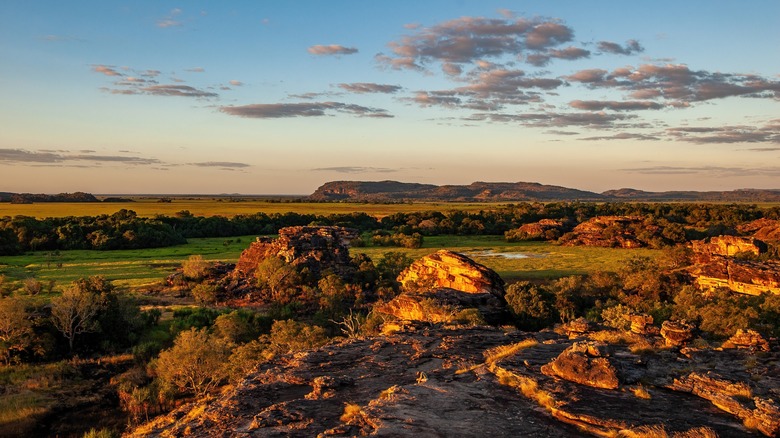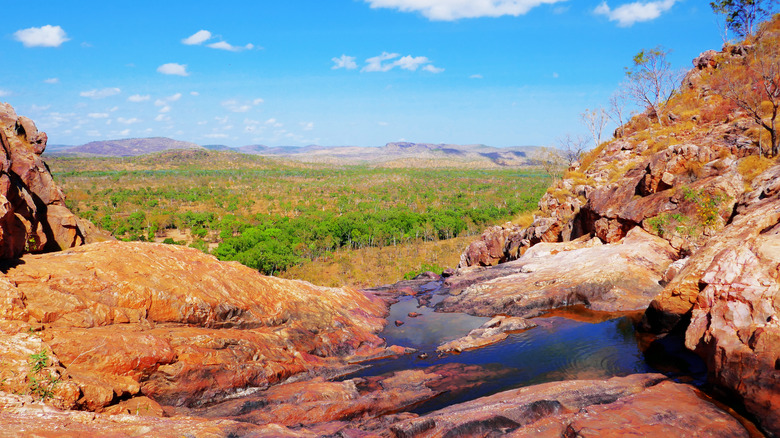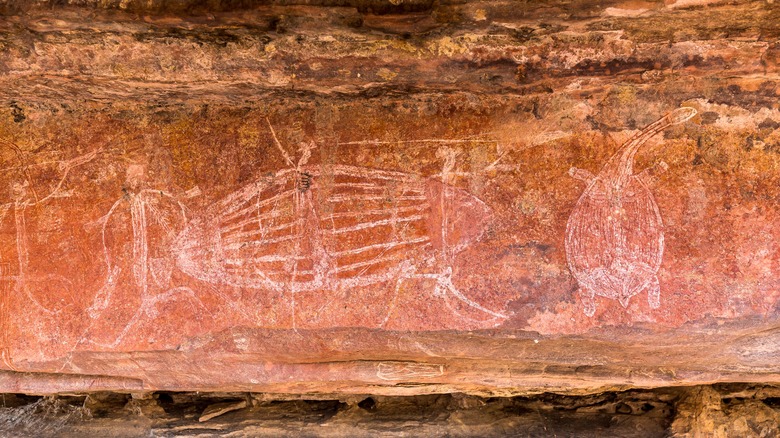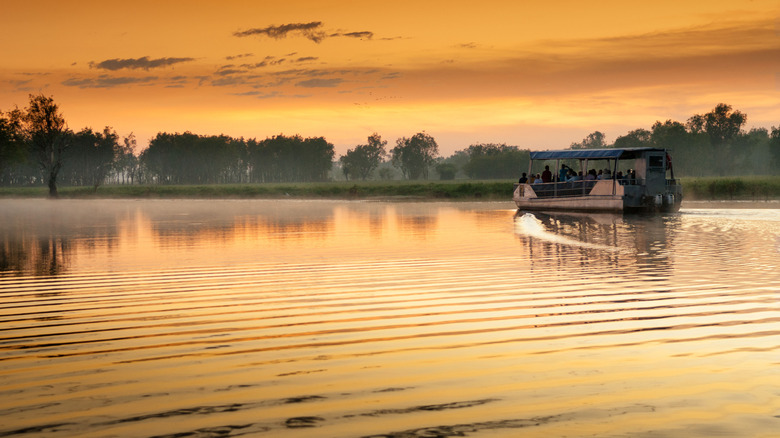This Incredible Australian National Park Is A Must-Visit For Stunning Landscape Views
If you've seen the movie "Crocodile Dundee," you're probably already convinced that Australia's Top End is a must-see. This area of the Northern Territory is a vast expanse of mesmerizing landscapes. Lush tropical bushland, stone escarpments, towering waterfalls, and calm billabongs make this part of Australia a must-see destination. Kakadu National Park, where many scenes from "Crocodile Dundee" were filmed, combines these landscapes in one sublime destination.
Kakadu covers an area of around 7,700 square miles. It's a UNESCO World Heritage site, recognized for its outstanding natural and cultural significance. As well as the landscapes, one of the most remarkable aspects of Kakadu is the continuous connection that the traditional owners, the Bininj/Mungguy, maintain with the land. These aboriginal groups have lived in the area for over 65,000 years, making theirs the oldest living culture on Earth. From rugged terrain to serene wetlands and ancient rock art, Kakadu National Park offers an unforgettable experience.
The diverse landscapes of Kakadu
Kakadu is known for its network of pristine waterways. You can explore the East Alligator River or Yellow Water Billabong by boat, surrounded by lush vegetation, diverse birdlife, and the occasional saltwater crocodile basking in the sun. The park is home to 10,000 crocodiles and just over 300 people — nature wins out here. The bloggers at Walk My World say their cruise on Yellow Water was the highlight of their Kakadu trip.
As well as rivers and billabongs, there are several magnificent waterfalls in Kakadu, with Jim Jim Falls being one of the most iconic. Jim Jim is accessible by 4WD and a bit of a hike, but the payoff is absolutely worth it as the sheer drop can leave you speechless. If you don't have a 4WD, Maguk and Gunlom are more easily accessible and should be on your list of places to go. You can swim in the pools at the top and bottom of these waterfalls (Always obey signs!). Gunlom's natural infinity pool, with views over a dense tree canopy, is particularly impressive.
To experience more of Kakadu's landscapes, lace up your hiking boots. A good place to start is with the Nawurlandja Lookout Walk. This 40-minute stroll offers incredible views over Anbangbang Billabong and the stone escarpment of Arnhem Land. One of the top-rated hikes in Kakadu is the Barrk Sandstone Walk. It's a challenging trek through bushland and mountains, making for incredible scenery.
Kakadu's ancient culture
Hidden within the park's rocky outcrops and shelters, you'll find some of the world's oldest rock art, with some paintings up to 20,000 years old. Burrungkuy (Nourlangie) and Ubirr are two prominent sites where you can admire these ancient artworks and gain insights into the history of the land and its people. You'll see paintings depicting animals, creation stories, and first contact with Europeans. Ubirr is also a favorite place to watch the sunset, so head there in the evening and watch the light change over the floodplain and the Arnhem Land escarpment.
If you want to learn more about indigenous culture in Kakadu, visit the Warradjan Aboriginal Cultural Center. Here, you can enjoy interactive displays and objects that will give you an insight into Aboriginal history. You can also watch local people creating traditional crafts that you can bring home as souvenirs.
If you're feeling adventurous, do a Rock Art Tour with Injalak Arts. During the three-hour guided walk, you'll learn about the indigenous relationship with the land and see spectacular ancient rock art. Injalak Arts is also a wonderful place to buy Aboriginal art. Note that the center is in Arnhem Land, just outside Kakadu, and you will need a permit from the Northern Land Council to participate.
The practicalities of visiting Kakadu
Kakadu isn't a place you can just casually drop into your Australia itinerary. It would take over 40 hours to drivefrom Sydney. For the shortest journey, fly to the Northern Territory capital of Darwin and hire a car or take a tour. You don't need a 4WD to explore Kakadu, but roads can be rough, and without a 4WD, there'll be certain places you can't go.
All visitors need a park pass to explore Kakadu. During the dry season, the pass costs $25 for adults and is valid for seven days. Most visitors go to Kakadu during the dry season, from approximately May to October. The majority of sites will be open at this time, including the natural pools for swimming. Temperatures are cooler, and it's, well, dry. Blogger Destinationless Travel recommends spending at least three days in the park and longer if you can.
The dry season is a great time to camp in Kakadu. There are several lodges in the park, so you don't have to camp, but pitching a tent offers a real Outback experience. Some campsites are free, though they have no facilities; others start from just $4 per person. When visiting the park, you'll want to pack bug spray and be croc-conscious.



